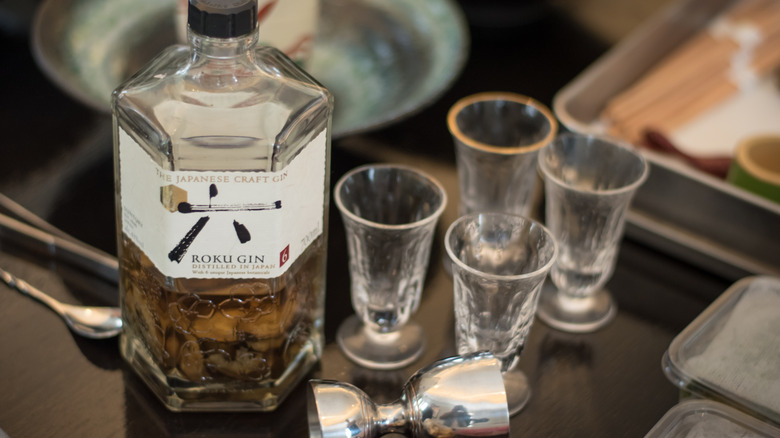What Makes Japanese Gin So Unique
Japanese gin has been around since the 1930s, when Suntory released their London Dry-style Hermes Dry Gin, according to Punch. However, it didn't really take off and it wasn't until recently that Japanese gin started making waves around the world. The first in the new age of Japanese gin was Ki No Bi, released in 2016 by The Kyoto Distillery, which had been formed by two Brits in Japan. Its popularity led two massive producers, Suntory and Nikka, to release their own gins, the Roku and Nikka Coffey Gin, in 2017. Today, there are more than 30 recorded gin distilleries in Japan, per Lifestyle Asia. While the Japanese domestic gin market grew 25% from 2015 to 2020, exports of Japanese gin have grown by 850% from 2016 to 2021 (via Forbes). A reason for the increasing popularity of Japanese gin is its uniqueness.
According to Masterclass, gin is defined by the use of juniper berries and other botanicals in the distillation process. What makes Japanese gin so unique are the botanicals that are used, in addition to the juniper berries. There is an emphasis on using botanicals and ingredients that are indigenous or common to Japan, such as yuzu peels, sansho peppers, gyokuro green tea, hinoki (Japanese cypress), shiso leaf, bamboo, and sakura (cherry blossoms), notes Drinks Geek. Some Japanese gins, like Roku and Ki No Bi, are also built around six distinct flavor categories: base, citrus, floral, herbal, spice, and tea.
The process for making Japanese gin is also unique
The distilling and blending process used by some Japanese producers is also unique. At many distilleries, botanicals are carefully selected, hand harvested, and macerated. They are then separately distilled before a final blend into the finished product. As Forbes explains, it's not unlike the process for making Japanese whiskies of "carefully blending daintily different whiskies." That unqiue process helps the botanicals to "retain their inherent flavors and distinct aromas," according to Punch, and a reason why Japanese gins tend to have a more distinctive taste, with a subtle juniper flavor that doesn't overwhelm.
The ingredients used to make the base alcohol in Japanese gin also differentiate it from its global counterparts. Elsewhere, gin was traditionally made from a base of grain (often wheat or barley), per Flaviar. Japanese gin, on the other hand, uses neutral grain spirits made from rice, barley, or corn — a result of whiskey or sochu production — though other bases are also used, including sweet potato liquor and Japanese tea aged in champagne barrels, notes Lifestyle Asia. So for a unique take on some of the best drinks to mix with gin, try some Japanese gin next time.

